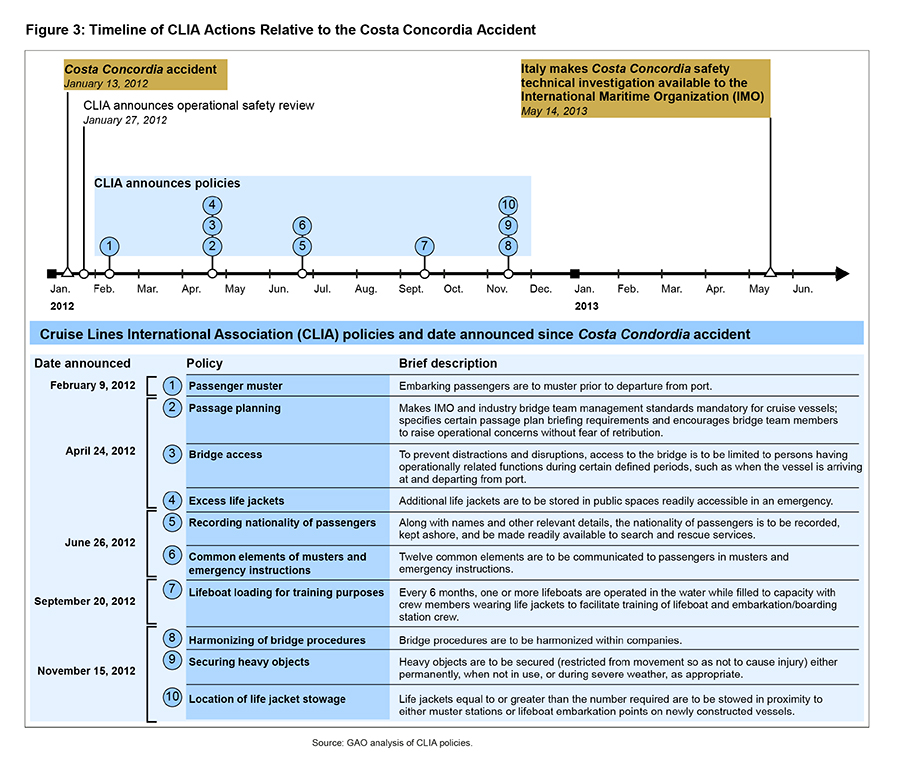Passenger Security and Safety on Cruise Ships
Planning a vacation this winter? Each year, millions of people board cruise ships departing from U.S. ports. We have done work on the security and safety requirements for cruise vessels that may give you a better understanding of how cruise lines and U.S. agencies are supposed to protect you, the passenger.
Cruise Ship Crime
One provision of the Cruise Vessel Security and Safety Act (CVSSA), enacted in 2010, required cruise lines with vessels that visit U.S. ports to report certain crimes that occur aboard their ships to the FBI and the U.S. Coast Guard. The U.S. Coast Guard maintains a website to publish information on the reported crimes that are no longer under investigation by the FBI. We found that the usefulness of some of the published data may be limited in three key ways:
- Completeness: Not all allegations are reported, such as those where investigations are not opened.
- Timeliness: Crime data posted on the website may represent incidents that occurred months or years in the past because of the lag between the time an alleged crime is reported and the time a case is closed.
- Relevance: Data posted on the website lack context that could help the public compare cruise vessel crime rates to land-based crime rates.
We also found that some cruise lines are making efforts to improve reported crime data. In August 2013, several cruise lines began voluntarily disclosing alleged crime data on their websites. Also, in July 2013, legislation was introduced to amend the CVSSA that would revise and expand crime-reporting requirements, among other items. Since these efforts were new or in process, it was too early for us to assess their long term impact.
Changes in Cruise Ship Safety since Costa Concordia Accident
The January 2012 grounding of the cruise vessel Costa Concordia off the coast of Italy resulted in the deaths of 32 passengers, raising questions, for example, about the procedures for safeguarding passengers in emergency situations. For example, although international maritime law requires all passengers to be evacuated within 30 minutes of an order to abandon a vessel, the Italian government reported that the evacuation of the Costa Concordia took more than 6 hours. The Italian government investigated the accident and reported in May 2013 on numerous lapses in emergency procedures and management, including problems with vessel evacuation, voyage planning, and emergency communication.
In response to the Costa Concordia accident, the Cruise Lines International Association (CLIA)—which represents over 98 percent of cruise lines in the United States—initiated a safety review to come up with new safety measures. The review identified 10 safety-related policies in 2012 that all member cruise lines adopted by July 2013, as you can see in the figure.
Timeline of CLIA Actions Relative to the Costa Concordia Accident
Image excerpted from GAO-14-43
For example, one measure includes passengers doing their evacuation drills before the ship actually departs. Another includes additional life jackets that would be stored in public spaces so people would not have to go back to their cabins to get their life jackets if something happened suddenly. It is important to note at this point, though, that these are all being done voluntarily. The Coast Guard, so far, has not adopted any new regulations related to safety after the Costa Concordia accident.
For more information on cruise ship safety and security check out our report or listen to the podcast.
Comments on GAO’s WatchBlog? Contact blog@gao.gov.
GAO Contacts
Related Products

GAO's mission is to provide Congress with fact-based, nonpartisan information that can help improve federal government performance and ensure accountability for the benefit of the American people. GAO launched its WatchBlog in January, 2014, as part of its continuing effort to reach its audiences—Congress and the American people—where they are currently looking for information.
The blog format allows GAO to provide a little more context about its work than it can offer on its other social media platforms. Posts will tie GAO work to current events and the news; show how GAO’s work is affecting agencies or legislation; highlight reports, testimonies, and issue areas where GAO does work; and provide information about GAO itself, among other things.
Please send any feedback on GAO's WatchBlog to blog@gao.gov.





